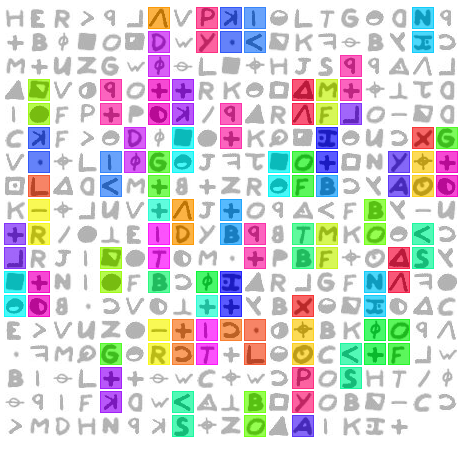I posted a new article and tools on the ZodiacKillerCiphers wiki for my “Hypothesis Testing” approach:
http://zodiackillerciphers.com/wiki/ind … is_Testing
The basic idea is that we don’t yet know how Z340 was constructed, so let’s rule out some encipherment schemes by making a bunch of test ciphers. If we can crack the test ciphers but not Z340, then we can exclude a hypothesis and move on to another one. So far, I’ve generated test ciphers for three different schemes: 1) Homophonic substitution, 2) Columnar transposition + homophonic substitution, and 3) Scytale transposition + homophonic substitution. I will gradually add more whenever I find the time.
Each hypothesis is linked to at least 100 test ciphers. You can get them as a big text file, or you can use an interactive cipher feature explorer tool that I built to visualize Z340-like features in the generated ciphers:
hypothesis 1: http://zodiackillerciphers.com/hypothes … dex-1.html
hypothesis 2: http://zodiackillerciphers.com/hypothes … dex-2.html
hypothesis 3: http://zodiackillerciphers.com/hypothes … dex-3.html
Works best in desktop web browsers – I don’t recommend trying to use it via smart phone web browsers.
Some quick instructions: Use the arrows and the drop down list to move between the different ciphers.

Hover over the different buttons to highlight different features.






(notice that the cipher is re-written to 19 columns to better show the period 19 repeats)




(notice that it shows the full sequence of symbols at the bottom)


The link at the bottom takes you to the text file that contains every cipher for that hypothesis:

Let me know if you find any problems with the tool.
There are so many more hypotheses to explore. Hopefully we can narrow the search to the most probable ones, since there are so many to pick from. One way to narrow the list is to see which schemes have higher rates of production of rare phenomena such as the pivots and periodic repeating bigrams.
Doranchak, that’s fantastic.
hI Doranchak.. I am presuming that your Generated scytale transposition + homophonic substitution cipher 19 is in fact a (19) position shift by column.. the reason I say this is that it does not represent the Physical ones I have made..
hI Doranchak.. I am presuming that your Generated scytale transposition + homophonic substitution cipher 19 is in fact a (19) position shift by column.. the reason I say this is that it does not represent the Physical ones I have made..
I am using the implementation that also can be found here:
http://www.cryptool-online.org/index.ph … 73&lang=en
Can you explain the difference between that scytale and your scytale? Maybe I should generate ciphers of both varieties.
Doranchak, when you say "columnar transposition," do you mean route transposition where the plaintext is transposed by taking them off in columns, or do you mean keyed columnar transposition?
Doranchak, when you say "columnar transposition," do you mean route transposition where the plaintext is transposed by taking them off in columns, or do you mean keyed columnar transposition?
The columnar transposition I implemented is described here: https://en.wikipedia.org/wiki/Transposi … nsposition
But instead of using a keyword to determine the column ordering, I am using a completely randomized column selection (a set of column numbers is directly used, rather than computing one based on a key word or phrase).
hI Doranchak.. I am presuming that your Generated scytale transposition + homophonic substitution cipher 19 is in fact a (19) position shift by column.. the reason I say this is that it does not represent the Physical ones I have made..
I am using the implementation that also can be found here:
http://www.cryptool-online.org/index.ph … 73&lang=en
Can you explain the difference between that scytale and your scytale? Maybe I should generate ciphers of both varieties.
The only way to explain it is to make a physical period 19 scytale . And then deconstruct it. It is very therapeutic. ![]()
The cipher order syctake/HSC wouldnt have much effect except reordering the HSC cycle symbols.
The scytale should be able to be modeled by the period/Modulus transposition that we have all done.
I am currently having a play with myszkowski transposition.
Due to the 78 coincidence i have assumed a key length of 13.
Noticing Z reference to z340 in the z13 letter i have scan the keyspace with z13 key pattern
but have not hit anything i am currently brute forcing the entire L13 keyspace.
The thing about myszkowski is that it will have the same output as columnar, redefence ciphers.
Regards
Bart
I know there is a half baked thread on morse code (each to their own) on here but has anyone done a proper frantionaled morse research on z340?
I am currently writing an encoder for another project but it kicked up some ideas in relation to z340.
Like Doranchak said "too many idea not enough time" (more or less)
Regards
Bart
